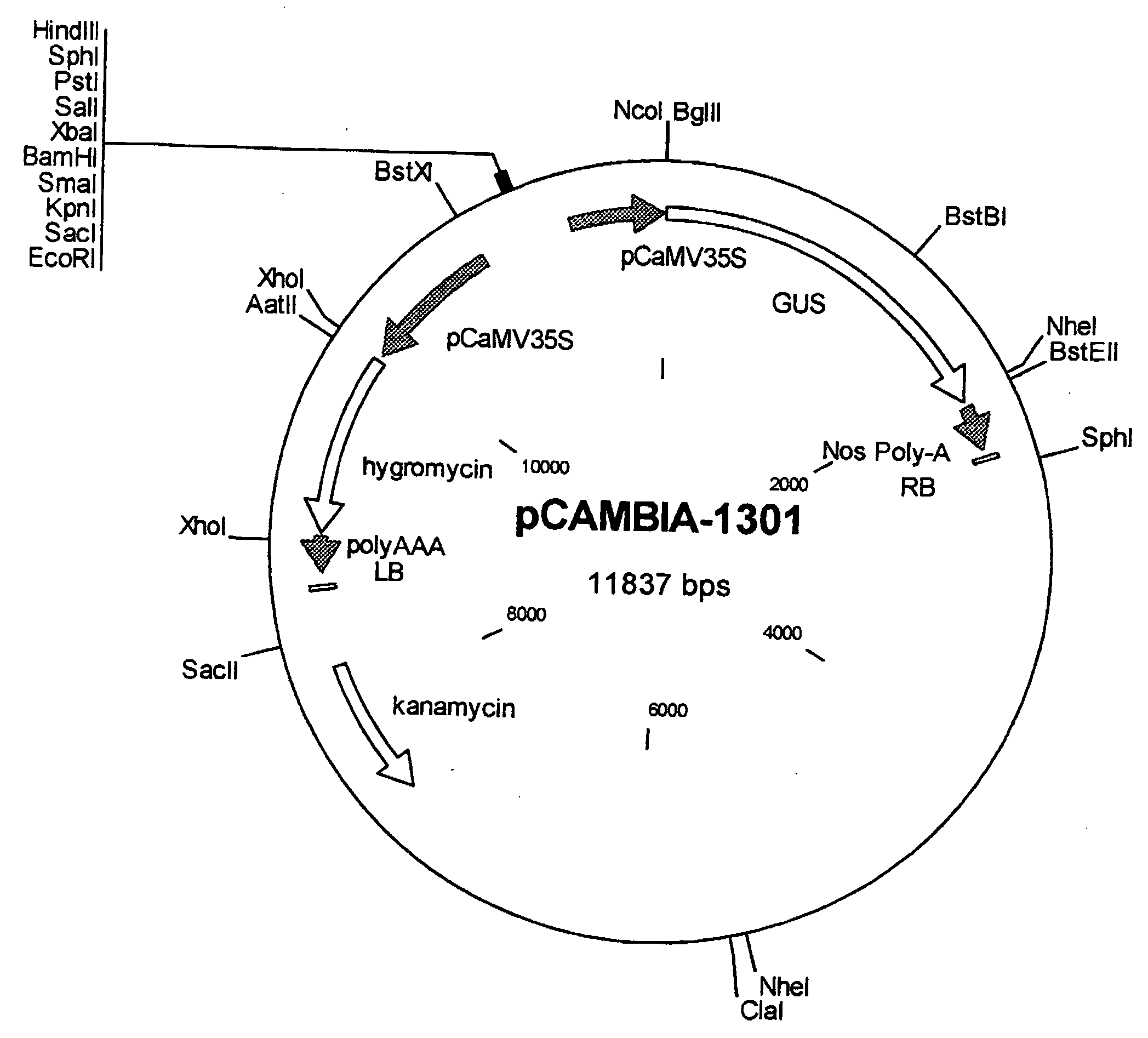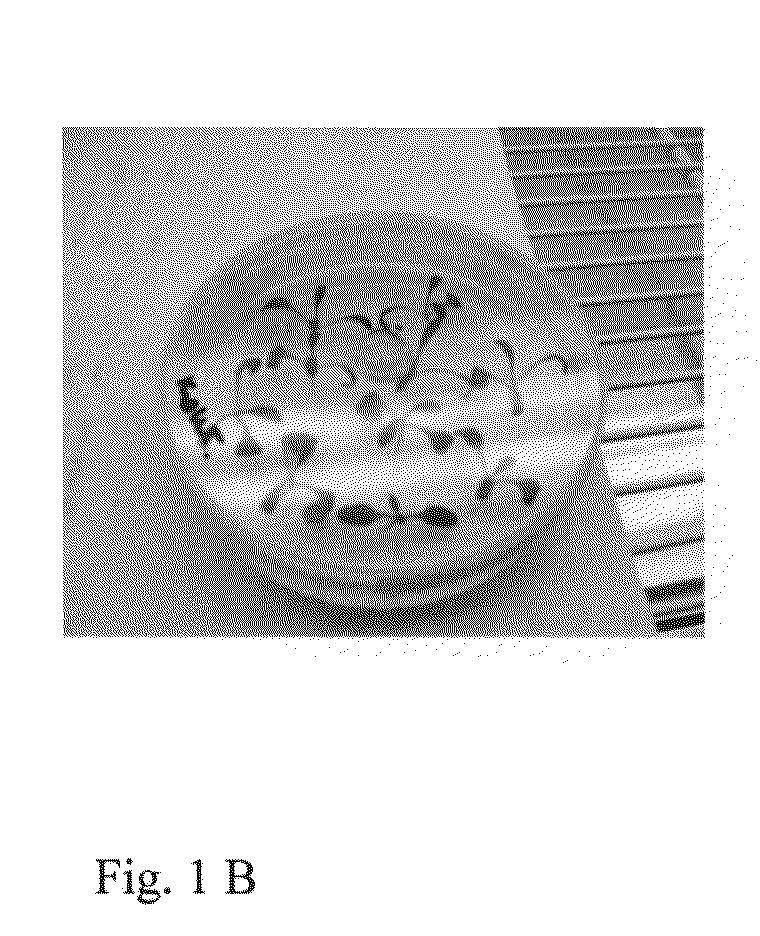Transformation system for Camelina sativa
a technology of transformation system and camelina sativa, which is applied in the field of plant biotechnology and plant cell transformation, can solve the problems of limited traditional plant breeding, time-consuming and even impossible alteration of single characteristics without changing any other properties, and no universal transformation method for different, so as to achieve rapid improvement of this crop
- Summary
- Abstract
- Description
- Claims
- Application Information
AI Technical Summary
Benefits of technology
Problems solved by technology
Method used
Image
Examples
example 1
Transformation Protocol for Camelina sativa cv. Calena with Agrobacterium tumefaciens Strain LBA4404 Harboring the Binary Plasmid pGPTV-HPT with uidA Intron Containing Gene
[0059]The seeds of Camelina sativa plant grown in greenhouse were sterilized by immersing in 70% ethanol for 1 min and then treating for 10 min with Na-hypochlorite solution (3% active Cl−) with an addition of Tween-20 (1 drop per 100 ml). After sterilization the seeds were washed three times in sterile water and placed on solid MS-agar medium without sugars for germination. Sterilized seeds were germinated and grown 2-3 weeks on solid MS medium without hormones (FIG. 1). Green leaves served as a source of explants for transformation procedure.
[0060]Agrobacterium tumefaciens strain LBA4404 carrying pGPTV-HPT-GUSint vector was grown overnight at 28° C. with shaking in liquid YEB medium supplemented with 50 mg / l kanamycin and rifampicin. Subsequently an aliquot of the culture (1 / 100 v / v) was inoculated in fresh YEB ...
example 2
Transformation Protocol for Camelina sativa cv. Calinca with Agrobacterium tumefaciens Strain C58C1 pGV3850 Harboring the Binary Ti Vector with Kanamycin Selection
10 Days Before Excision of the Explants.
[0063]Seeds of greenhouse grown Camelina sativa cv. Calinca plants (not older than 4 months) were sterilized and placed in vitro on MS-agar medium without sucrose and grown at temperatures of 25° C. (day) and 18° C. (night) as described in Example 1.
1st Day.
[0064]A fresh colony of Agrobacterium tumefaciens strain C58C1pGV3850 carrying binary pGPTV-KAN vector containing uicA-int gene under 35S promoter and selectable marker gene nptII, was inoculated in 3 ml of liquid YEB medium supplemented with 25 mg / l rifampicin (Rif) and 50 mg / l kanamycin (Kan). The bacteria were grown overnight with shaking at 28° C.
2nd Day. Pre-Cultivation.
[0065]The first leaves (not cotyledons) of in vitro grown Camelina sativa were cut into segments across the leaf and were placed on pre-cultivation plates con...
example 3
Transformation Protocol for Camelina sativa cv. Calena with Agrobacterium tumefaciens Strain C58C1 pGV3850 Harboring Cointegrative Ti DNA without Selection of Transgenic Tissues
10 Days Before Explants Excision.
[0072]Seeds of green house grown Camelina sativa cv. Calena plants (no older than 4 months) were sterilized and placed in vitro on MS-medium without sucrose and grown at temperatures of 25° C. (day) and 18° C. (night) as described in Example 1.
1st Day.
[0073]A fresh colony of C58C1pGV3850 with interned Ti DNA from pHTT-HPT vector containing GUS gene under 35S promoter and hpt selectable marker was inoculated in 3 ml of liquid YEB supplemented with 25 mg / l rifampicin (Rif) and 100 mg / l spectinomycin (Spe) or streptomycin (Str). The bacteria were grown overnight with shaking at 28° C.
2nd Day. Pre-Cultivation.
[0074]The first leaves (not cotyledons) were cut into segments across the leaf and placed onto the pre-cultivation plates containing 0.7% MS-agar medium with 2% sucrose suppl...
PUM
| Property | Measurement | Unit |
|---|---|---|
| temperatures | aaaaa | aaaaa |
| concentrations | aaaaa | aaaaa |
| size | aaaaa | aaaaa |
Abstract
Description
Claims
Application Information
 Login to View More
Login to View More - R&D
- Intellectual Property
- Life Sciences
- Materials
- Tech Scout
- Unparalleled Data Quality
- Higher Quality Content
- 60% Fewer Hallucinations
Browse by: Latest US Patents, China's latest patents, Technical Efficacy Thesaurus, Application Domain, Technology Topic, Popular Technical Reports.
© 2025 PatSnap. All rights reserved.Legal|Privacy policy|Modern Slavery Act Transparency Statement|Sitemap|About US| Contact US: help@patsnap.com



